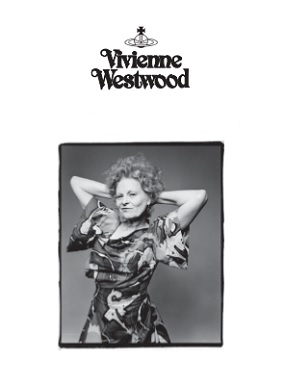A Profile and Timeline of Vivienne Westwood
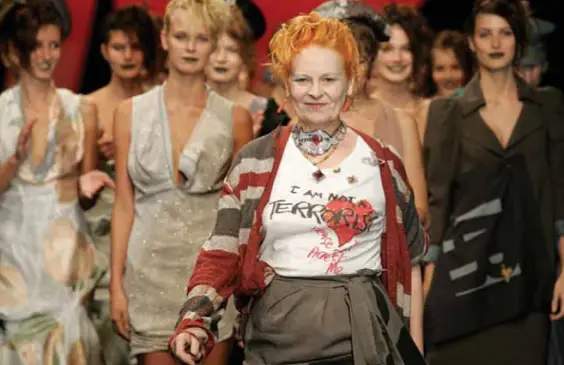
A Life of Surprises
As Vivienne Westwood’s Victoria Quarter Leeds outlet re-launches as a Flagship Store, Matt Callard looks back on the life of Brit fashion’s greatest, and most controversial, icon…
The unholy flame-haired and wholly authentic King’s Road punk trinity are still burning bright.
Lydon, dragging his crazy selection of pants across diabolical reality TV, the rock nostalgia circuit and quivering morning chat-show sofas. Closer now than he ever really wanted to be to the title of ‘Greatest Living Englishman’. But don’t ever call him dull. Just when you think he’s gone a little bit soft he’ll snap like the Rottweiler you thought you’d tamed.
McLaren, still crafty as ever, still impeccably dressed and quotable, still getting up all the right noses – likewise incapable of dullness. God only knows what he’s planning next (something to do with a musical and Christian Dior, apparently) but you can be sure it will be irritating and fabulous and, yes, a little bit anarchic.
And, of course, that woman. With her singular visions, her blunt northern-ness, her never-ending creative forces. She’s lots of things, that woman, but she’s never dull.
Yes, the Spirit of Punk Rock is alive and well. It’s just wearing haute couture.
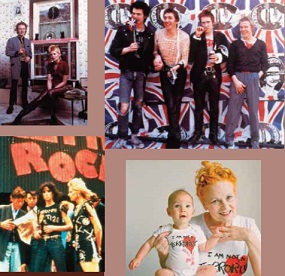 The Manifesto
The Manifesto
Vivienne Westwood has a Manifesto. Its name is ‘Active Resistance’. In it she makes the (admittedly bold) claim that ‘(the Manifesto) penetrates to the root of the human predicament and offers the underlying solution.’ Vivienne Westwood is a 68-year old-grandmother.
Most people’s revolutionary urges become abandoned in the midst of a cider and black hangover, some time before their first proper shave (chins and legs) so it’s with a slightly patronising sense of admiration that I plough through said Manifesto. She’d probably give me a right hook for the condescension but it’s a great achievement to still be idealistic enough to want to change the world and simultaneously qualify for a free bus pass.
The Manifesto presents as a sprawling fantasy vignette involving, among many others, Pinocchio, Aristotle and Hitler. In the good name of On: Magazine, I read it. It’s headache-inducing and borderline impenetrable – a vanity project, even – but in true punk rock style it very loudly screams: ‘I’m trying to change the world, are you?’
Gulp.
And Vivienne Westwood is deadly serious about it. In truth she ‘merely’ wants to ‘sow the seeds’ of change, claiming the Manifesto is ‘the result of a lifetime’s thinking in the fields of heretical opinion.’ It’s all there online if you want to immerse – but don’t forget the tablets.
Fashion Icon
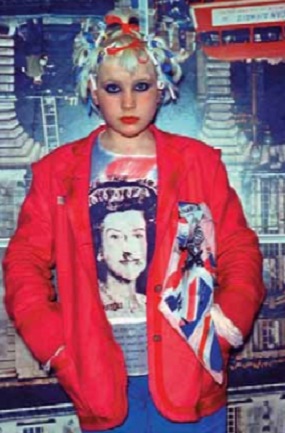 Oh, and Vivienne Westwood is a fashion designer. Not just any fashion designer, of course (brace yourself) – she’s been British Fashion Designer of the Year three times, is Professor of Fashion at the Vienna Academy of Arts, is a Senior Fellow of the Royal College of Art, was the first designer to be honoured at the Moët & Chandon Fashion Tribute, has had her own major retrospective at the V&A, was awarded the UK fashion Export Award for Design and received the Lifetime Achievement accolade at the British Fashion Awards. And she’s a Dame. And has an OBE.
Oh, and Vivienne Westwood is a fashion designer. Not just any fashion designer, of course (brace yourself) – she’s been British Fashion Designer of the Year three times, is Professor of Fashion at the Vienna Academy of Arts, is a Senior Fellow of the Royal College of Art, was the first designer to be honoured at the Moët & Chandon Fashion Tribute, has had her own major retrospective at the V&A, was awarded the UK fashion Export Award for Design and received the Lifetime Achievement accolade at the British Fashion Awards. And she’s a Dame. And has an OBE.
It wasn’t always thus. She’d been designing for 15 years before her legendary mini-crinis (a combination of tutu, Crinoline, party frock and Disney cartoon) are appropriated (ripped-off) by just about every fashion house in existence.
It isn’t until the late eighties that she is in the same company as Armani, Lagerfeld, Lacroix et al.
Boutiques
She’d already had two children, one (Benjamin) with her first husband Derek Westwood in 1963 and another (Joseph, the future co-founder of lingerie chain Agent Provocateur) with McLaren in 1967 (she divorced Derek and met McLaren in ’65) before the pair opened their first store, Let It Rock, at 430 King’s Road, London. They sold clothes mostly influenced by the Teddy Boy aesthetic of the fifties. The shop is adorned with Odeon wallpaper and austerity furniture and packed with ephemera. View the shop as a ‘work in progress’ – constantly evolving, forever pushing boundaries, magnet for the outré and the out-there – Vivienne Westwood personified, in fact.
It wasn’t until ’75, however, with the burgeoning proto-punk scene drawn to the shop’s new collection of bondage trousers, rubber, safety pins, crude and provocative t-shirts and, no doubt, its new name; Sex, that everything changed. When a young four-piece band, wearing the shop’s designs, played an explosive debut gig at Central St Martin’s School of Art, a nation dozing in their beige and cream armchairs suddenly sat up. Some are aghast, some are thrilled, but everyone notices. The band, famously (mis)managed by McLaren, are called The Sex Pistols.
The Eighties
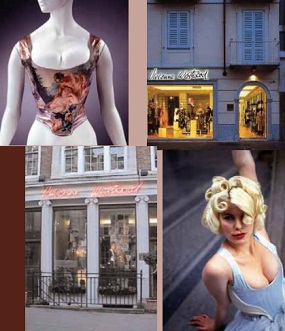 As punk blazes a brief but unforgettable trail across the detritus of seventies Britain, Westwood moves on (“The last thing I want to do is move with the times,” she once said). Not content with delivering one Culture Shock she embarks on her ‘Pirates’ collection. Bringing to the fore her soon-to-be renowned penchant for raiding history for inspiration, her new designs are billowing, lavish and flamboyant takes on 18th Century men’s clothing fused with North American Indian and pirate styles. In the process she (perhaps inadvertently) invents new romanticism, the new sexual androgyny (as with punk, the garments are unisex) and, in his entirety, the first genuine pop star of the decade, Adam Ant.
As punk blazes a brief but unforgettable trail across the detritus of seventies Britain, Westwood moves on (“The last thing I want to do is move with the times,” she once said). Not content with delivering one Culture Shock she embarks on her ‘Pirates’ collection. Bringing to the fore her soon-to-be renowned penchant for raiding history for inspiration, her new designs are billowing, lavish and flamboyant takes on 18th Century men’s clothing fused with North American Indian and pirate styles. In the process she (perhaps inadvertently) invents new romanticism, the new sexual androgyny (as with punk, the garments are unisex) and, in his entirety, the first genuine pop star of the decade, Adam Ant.
Two other collections, ‘Savages’ and ‘Buffalo,’ follow with McLaren again attempting his pop Svengali thing (anyone still remember Bow Wow Wow or those Buffalo Girls?) but they have set such outrageously high standards with punk and the new romantics that their impacts are inevitably quieter.
Another re-name of the shop follows, the outlet becomes known as ‘World’s End’ and the name remains to this day. But mainstream success (and, arguably, peer respect) still eludes her. The business runs into financial difficulties and Westwood splits from McLaren and moves to Italy with new lover and long-term financial backer Carlo D’Amario. Not coincidently Italy is one of the few places her creations are revered. A life-changing deal with Armani soon follows. All of a sudden, unshackled from monetary constraints and the dual-intentions of Malcolm McLaren, Vivienne Westwood as the ‘Designer’s Designer,’ is unleashed.
The Mini-Crini
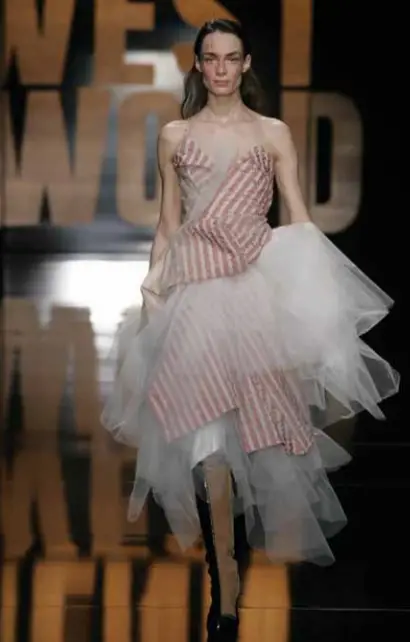 When Westwood returns to the clothes scene, after indulging her long-term fascination for Historicism with some meticulous research and a healthy dose of inspiration from the ballet Petrushka, she turns the Fashion World upside-down.
When Westwood returns to the clothes scene, after indulging her long-term fascination for Historicism with some meticulous research and a healthy dose of inspiration from the ballet Petrushka, she turns the Fashion World upside-down.
Entirely at odds with the big-shoulders and masculine power-dressing of mainstream 80’s fashion, and revelling in the incongruous blend of polka-dot or Disney mini-skirts with corsets and crinoline, the Mini-Crini embraces femininity by framing the body in a swaying bell-shaped skirt (essentially an audacious re-vamp of the 19th Century crinoline with added tutu) that firmly emphasises the hips. This extraordinary blend – the historical with the modern, the childlike with the sexually-charged, a fearless nonconformity alongside rigid tradition, remain Vivienne Westwood’s trademarks to this day. When she says: “I’m never happier than when I’m parodying the English,” she means it.
Back living in England and split from D’Amario, Westwood, a year on from the Mini-Crini, remarkably manages to emulate that show’s impact. In a collection which Karl Lagerfeld describes as ‘one of the most important fashion ideas of the 21st century’ she continues her gentle prodding of the British establishment with her ironic and iconic Harris-Tweed collection.
Taking inspiration from Savile Row and using various classic tweeds, the clothes evoke the Old England of boarding schools, country houses and game shooting. Describing the collection herself (never one of her favourite pastimes), she says: “I’m not really trying to be English — you can’t avoid it, it’s what you’ve absorbed. I do have fun knowing that I am doing it. I very much enjoy parody and this English sort of lifestyle… and I really am in love with the fabrics.”
The Nineties
Vivienne Westwood’s approach to fashion, no matter how thrillingly absurd it may initially seem, is rooted in the practical. She always designs for women with breasts and hips. Which, despite her nineties move away from street-style into haute couture, makes her a friend of the woman-in-the-street.
She might occasionally seem other-worldly, sometimes come across as a cultural snob (“People don’t know what ‘culture’ means”), intermittently send out conflicting messages (as Suzy Menkes, long-time fashion editor of the International Herald Tribune, put it after one of her last collections: ‘How dare she send out a show laced with anarchist messages, take her bow in a clinging dress with the word “propaganda” spiralling around her ample figure, announce that the spirit of her show is “the more you consume, the less you think” and then take the opportunity to launch her collection of punk safety pins in diamonds?’), but she’s never anything less than terrific value.
An increased confidence in tailoring precedes her first proper men’s collection, ‘Cut and Slash’ which opens in 1990. The Award floodgates open up, swallowing up, in the next decade, just about everything the fashion world can throw at her.
She marries long-term partner Andreas Kronthaler in ‘93 and the couple are still together today. The VW label embraces branding – jewellery, watches and that fashion-house must-have, the perfume. In the process, watering down the singular identity of the company a tad whilst adding a few zeros to the bank balance. The collections still came thick and fast. They are always challenging, always entertaining (featuring Naomi Campbell’s famous topple in those sky-scraping platform shoes), still joyfully careless the nearer she gets to the Establishment. She casually collects her OBE wearing silver horns and no underwear.
Today
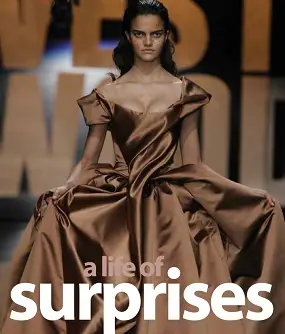 The clothes don’t shock anymore. They make you ooh-and-aah. And, in the case of Sarah Jessica Parker in that wedding dress in the Sex and the City movie, swoon a little. Dame Vivienne seems increasingly fond of frustrating journalists by talking less and less about clothes and more and more about art (usually her beloved Dutch masters) and politics (an array of genuinely worthy topics).
The clothes don’t shock anymore. They make you ooh-and-aah. And, in the case of Sarah Jessica Parker in that wedding dress in the Sex and the City movie, swoon a little. Dame Vivienne seems increasingly fond of frustrating journalists by talking less and less about clothes and more and more about art (usually her beloved Dutch masters) and politics (an array of genuinely worthy topics).
References to high art and literature run through her modern, global collections, putting historicism mostly to one side. She seems much more respectful to the craft she once ripped and slashed her way through. She recently said: “Art must be anchored in technique. This means the manipulation of materials. In my case my materials are essentially the human and cloth. It is my job to make the cloth give expression to the body of a human being.”
Distilling the life and work of Vivienne Westwood into 2,000 words is close to impossible. She summed up the 21st century version succinctly herself when she said: “In the end, I am a couturier. A designer who is comfortable doing street fashion and a couturier who has a maison where I do made-to-measure couture clothes.” But the whole picture, the VW historicism is a much more complicated affair.
What’s clear is her story is an extraordinary one. A central and subversive figure in punk’s anti-establishment heroics who became, through appropriation of the themes and styles of the establishment, an establishment figure herself. Only one that continually nose-thumbed back.
All that outrage, all that non-compromise, all that opposition to dullness. Yes, the flame is still burning bright. And that woman, don’t rule her out of striking one more match for brilliant individualism.
6 of the best quotes
“The only reason I’m in fashion is to destroy the word ‘conformity’. Nothing’s interesting to me unless it’s got that element.”
“Every time I have to look up a word in the dictionary, I’m delighted.”
“If you hear ‘Anarchy in the UK’ today your hair stands on end. It gives you the shivers. But some of them are still stuck on their pedestals. I moved on. I realised that it’s only ideas that are subversive in the end. It’s not rushing around being a rebel.”
“All I’ve got at home are two second-hand armchairs, a trestle table, a fridge and a cooker.”
“Those supermodels, they are the greatest thing. Each one of them seems to be the epitome of an idea or a look, or a feeling.”
“I am a great believer in copying; there has never been an age in which people have so little respect for the past.”
At a Glance
1941 Born Vivienne Isabel Swire on April 8th in Glossop, Derbyshire.
1957 Moves to London and attends Harrow Art School for one term.
1962 Aged 21 marries Derek Westwood and becomes a primary-school teacher in North London
1963 Her first son Benjamin is born
1965 Marriage to Derek ends. First meets Malcolm Edwards (aka McLaren)
1967 Has second child, Joseph, with McLaren
1971 Opens her first shop, with McLaren, at 430 King’s Road London. They call it ‘Let It Rock.’
1972 The shop’s first name change – this time it’s, ‘Too Fast To Live, Too Young To Die’.
1974 Third change – and most famous – they re-Christen the store, ‘Sex’.
Timeline
- 1976 With a devoted punk following in tow, the shop gets another rename – ‘Seditionaries – Clothes for Heroes’.
- 1979 The final rename – ‘World’s End’ – the shop still exists today.
- 1981 The pair stage their first ever catwalk show, ‘Pirates.’
- 1982 Their ‘Buffalo’ and ’Punkature’ collections show in Paris and a second London shop is opened – ‘Nostalgia of Mud’.
- 1983 ‘Witches’ collection shows in Paris.
- 1984 ‘Nostalgia of Mud’ closes. Westwood moves to Italy and splits from McLaren.
- 1986 Deal with Giorgio Armani is announced – the Mini Crini arrives.
- 1987 Westwood’s ironic and iconic Harris-Tweed collection divides opinion. It’s now regarded as a fashion statement classic.
- 1988 ‘Time Machine’ collection opens at London Olympia.
- 1989 A watershed moment. Westwood is named in John Fairchild’s book ‘Chic Savages’ as one of the world’s top six designers. The other names are Armani, Lagerfeld, Saint Laurent, Lacroix and Ungaro. Everything changes.
- 1989 Appointed Professor of Fashion at Vienna Academy of Applied Arts.
- 1990 Cut and Slash is her first men swear collection.
- 1990 & 1991 Awarded Fashion Designer of the Year by The British Fashion Council.
History
- 1992 Introduces Wedding Gowns to the collections.
- 1992 Westwood is made Honorary Senior Fellow of the Royal College of Art and is awarded an OBE.
- 1993 Marries Andreas Kronthaler. The pair are still together.
- 1994 Invitation by Littlewoods catalogue to design a mail-order range.
- 1996 Westwood’s menswear label ‘Man’, is launched in January in Milan.
- 1998 Launches her debut fragrance, ‘Boudoir.’
- 1999 Opens first store in New York.
- 2001 Vivienne Westwood is the first designer to be honoured at the Moët & Chandon Fashion Tribute held at the V&A.
- 2002 Shop opens in Hong Kong.
- 2003 ‘Gold Label Street Theatre’ opens in Paris.
- 2004 Vivienne Westwood retrospective opens at the V&A.
- 2007 Presented with Lifetime Achievement prize at the British Fashion Awards – launches on-line Manifesto.
All images courtesy of Vivienne Westwood
This article was first published in 2008
(Malcolm McLaren died in 2010 – Ed)
